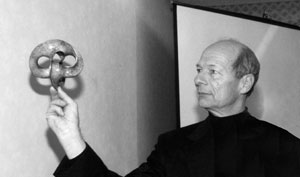|
HOME | SEARCH | ARCHIVE |
|
Computer scientist, artist make elegant art based on soap-bubble mathematics
Professor demonstrates work at AAAS conference
![]()
By Catherine Zandonella, Public Affairs
| |  Computer scientist Carlo Sequin displays a sculpture designed using his computer program. Peg Skorpinski photo |
21 February 2001
|
In a new expression of mathematically inspired art, computer scientist Carlo Séquin has developed computer programs used to create elegant sculptures based on the the mathematics found in curving shapes of soap bubbles. The Berkeley professor’s foray into art was inspired by the graceful geometrical wood forms of Missouri-based sculptor Brent Collins, whose work Séquin first saw in an issue of the art journal Leonardo. Séquin discussed his sculptures last week at the annual meeting of the American Association for the Advancement of Science in San Francisco. Collins’ sculptures of intertwined arches and saddles were the product of artistic intuition, not mathematical calculations. Yet, as Séquin noted, they exhibited the grace and balance of the saddle-shaped “minimal surfaces” formed by soap films stretched within twisted wire loops. These shapes have long fascinated mathematicians, as they represent the smallest area the film could conceivably occupy within the constraints of its borders. “To simulate these surfaces involves billions of computations,” says Séquin, “yet nature does it so easily.” Séquin gradually enhanced the program to produce sculptures with higher-order saddles — ones with three or more valleys between an equal number of upward-curving slopes. The program’s user-friendly interface makes it easy to experiment with various features of a design, such as the number of saddles and holes, the number of valleys in a saddle, the amount of twist, textures and colors. He also adjusted the program to produce intertwined loops of saddles — shapes impossible for Collins to conceive or build using his traditional approach. When both parties agree on a new form, Séquin’s program slices the geometrical shape into one-inch-wide cross sections and creates a set of full-size blueprints of the sculpture. Using these computer drawings as templates, Collins pre-cuts one-inch wood boards into convoluted shapes, which in turn are stacked to form the new sculpture. After a month of grinding and sanding, a beautiful, smooth shape with a satiny finish emerges. Artist and computer scientist alike have benefited from the collaboration. Before beginning a new project, Collins is now able to choose from a number of very complex prototypes. Séquin uses these artistic shapes to teach his students the principles of computer-aided design and rapid prototyping. Their artistic collaboration illustrates the potential use of computers for more than just computation, notes Séquin. “When used in such an interactive mode, the computer becomes an amplifier for the creative process.” See http://www.cs.berkeley.edu/~sequin/SCULPTS/scherk.html for photos of wood sculptures that Collins has created through computer-aided design.
Séquin contacted the artist to discuss his sculptures. He learned that for each new design, Collins first painstakingly fashions a prototype from wire mesh and beeswax. Séquin suggested the use of a computer program to visualize novel shapes in a fraction of the time it takes to build the prototypes. Séquin and his students did a few months of programming; the result was computer software that generates Collins-style sculptures in the form of a stack of simple saddles bent to form a circle.
Home | Search | Archive | About | Contact | More News
Copyright 2000, The Regents of the University of California.
Produced and maintained by the Office of Public Affairs at UC Berkeley.
Comments? E-mail berkeleyan@pa.urel.berkeley.edu.